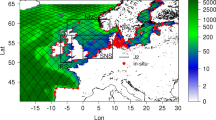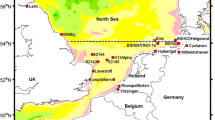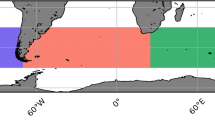Abstract
One of the main challenges of the Copernicus Marine Service is the implementation of coupled ocean/waves systems that accurately estimate the momentum and energy fluxes provided by the atmosphere to the ocean. This study aims to investigate the impact of forcing the Nucleus for European Modelling of the Ocean (NEMO) ocean model with forecasts from the wave model of Météo-France (MFWAM) to improve classical air-sea flux parametrizations, these latter being mostly driven by the 10-m wind. Three wave-related processes, namely, wave-state-dependent stress, Stokes drift-related effects (Stokes-Coriolis force, Stokes drift advection on tracers and on mass), and wave-state-dependent surface turbulence, are examined at a global scale with a horizontal resolution of 0.25°. Three years of sensitivity simulations (2014–2016) show positive feedback on sea surface temperature (SST) and currents when the wave model is used. A significant reduction in SST bias is observed in the tropical Atlantic Ocean. This is mainly due to the more realistic momentum flux provided by the wave model. In mid-latitudes, the most interesting impact occurs during the summer stratification, when the wind is low and the wave model produces a reduction in the turbulence linked with wave breaking. Magnitudes of the large-scale currents in the equatorial region are also improved by 10% compared to observations. In general, it is shown that using the wave model reduces on average the momentum and energy fluxes to the ocean in tropical regions, but increases them in mid-latitudes. These differences are in the order of 10 to 20% compared with the classical parametrizations found in stand-alone ocean models.












Similar content being viewed by others
References
Adcroft A, Hill C, Marshall J (1997) Representation of topography by shaved cells in a height coordinate ocean model. Mon Weather Rev 125:2293–2315. https://doi.org/10.1175/1520-0493(1997)125<2293:ROTBSC>2.0.CO;2
Akima H (1970) A new method of interpolation and smooth curve fitting based on local procedures. J ACM 17:589–602. https://doi.org/10.1145/321607.321609
Alari V, Staneva J, Breivik Ø, Bidlot JR, Mogensen K, Janssen P (2016) Surface wave effects on water temperature in the Baltic Sea: simulations with the coupled NEMO-WAM model. Ocean Dyn 66:917–930. https://doi.org/10.1007/s10236-016-0963-x
Amante C, Eakins BW (2009) ETOPO1 1 arc-minute global relief model: procedures, data sources and analysis. NOAA Tech Memo NESDIS NGDC-24:19. https://doi.org/10.1594/PANGAEA.769615
Ardhuin F, Rogers E, Babanin A et al (2010) Semi-empirical dissipation source functions for ocean waves: part I, definition, calibration and validation. https://doi.org/10.1175/2010JPO4324.1
Bakhoday Paskyabi M, Fer I, Jenkins AD (2012) Surface gravity wave effects on the upper ocean boundary layer: modification of a one-dimensional vertical mixing model. Cont Shelf Res 38:63–78. https://doi.org/10.1016/j.csr.2012.03.002
Becker JJ, Sandwell DT, Smith WHF, Braud J, Binder B, Depner J, Fabre D, Factor J, Ingalls S, Kim SH, Ladner R, Marks K, Nelson S, Pharaoh A, Trimmer R, von Rosenberg J, Wallace G, Weatherall P (2009) Global bathymetry and elevation data at 30 arc seconds resolution: SRTM30_PLUS. Mar Geod 32:355–371. https://doi.org/10.1080/01490410903297766
Bennis AC, Ardhuin F, Dumas F (2011) On the coupling of wave and three-dimensional circulation models: choice of theoretical framework, practical implementation and adiabatic tests. Ocean Model 40:260–272. https://doi.org/10.1016/j.ocemod.2011.09.003
Bernard B, Madec G, Penduff T, Molines JM, Treguier AM, le Sommer J, Beckmann A, Biastoch A, Böning C, Dengg J, Derval C, Durand E, Gulev S, Remy E, Talandier C, Theetten S, Maltrud M, McClean J, de Cuevas B (2006) Impact of partial steps and momentum advection schemes in a global ocean circulation model at eddy-permitting resolution. Ocean Dyn 56:543–567. https://doi.org/10.1007/s10236-006-0082-1
Bolaños R, Brown JM, Souza AJ (2014) Wave-current interactions in a tide dominated estuary. Cont Shelf Res 87:109–123. https://doi.org/10.1016/j.csr.2014.05.009
Breivik Ø, Bidlot JR, Janssen PAEM (2016) A stokes drift approximation based on the Phillips spectrum. Ocean Model 100:49–56. https://doi.org/10.1016/j.ocemod.2016.01.005
Breivik O, Mogensen K, Bidlot JR, Balmaseda MA, Janssen PAEM (2015) Surface wave effects in the NEMO ocean model: forced and coupled experiments. J Geophys Res C Ocean 120:2973–2992. https://doi.org/10.1002/2014JC010565
Brodeau L, Barnier B, Gulev SK, Woods C (2017) Climatologically significant effects of some approximations in the bulk parameterizations of turbulent air–sea fluxes. J Phys Oceanogr 47:5–28. https://doi.org/10.1175/JPO-D-16-0169.1
Charnock H (1955) Wind stress on a water surface. Q J R Meteorol Soc 81:639–640
Craig PD, Banner ML (1994) Modeling wave-enhanced turbulence in the ocean surface layer. J Phys Oceanogr 24:2546–2559
Dee DP, Uppala SM, Simmons AJ, Berrisford P, Poli P, Kobayashi S, Andrae U, Balmaseda MA, Balsamo G, Bauer P, Bechtold P, Beljaars ACM, van de Berg L, Bidlot J, Bormann N, Delsol C, Dragani R, Fuentes M, Geer AJ, Haimberger L, Healy SB, Hersbach H, Hólm EV, Isaksen L, Kållberg P, Köhler M, Matricardi M, McNally AP, Monge-Sanz BM, Morcrette JJ, Park BK, Peubey C, de Rosnay P, Tavolato C, Thépaut JN, Vitart F (2011) The ERA-interim reanalysis: configuration and performance of the data assimilation system. Q J R Meteorol Soc 137:553–597. https://doi.org/10.1002/qj.828
Donlon CJ, Martin M, Stark J, Roberts-Jones J, Fiedler E, Wimmer W (2012) The operational sea surface temperature and sea ice analysis (OSTIA) system. Remote Sens Environ 116:140–158. https://doi.org/10.1016/j.rse.2010.10.017
ECMWF (2015) Part VII: ECMWF wave model. IFS Doc CY41R1 1–83
Grant WD, Madsen OS (1979) Combined wave and current interaction with a rough bottom. J Geophys Res Ocean 84:1797–1808. https://doi.org/10.1029/JC084iC04p01797
Gusdal Y, Carrasco A, Furevik BR (2010) Validation of the operational wave model WAM and SWAN - 2009. October
Hilburn KA, Wentz FJ (2008) Intercalibrated passive microwave rain products from the Unified Microwave Ocean Retrieval Algorithm (UMORA). J Appl Meteorol Climatol 47:778–794. https://doi.org/10.1175/2007JAMC1635.1
Janssen PAEM (1991) Quasi-linear theory of wind-wave generation applied to wave forecasting. J Phys Oceanogr 21:1631–1642
Jenkins AD (1987) Wind and wave induced currents in a rotating sea with depth-varying eddy viscosity. J Phys Oceanogr 17:938–951
Jordà G, Bolaños R, Espino M, Sánchez-Arcilla A (2007) Assessment of the importance of the current-wave coupling in the shelf ocean forecasts. Ocean Sci 3:345–362. https://doi.org/10.5194/os-3-345-2007
Kara AB, Metzger EJ, Bourassa MA (2007) Ocean current and wave effects on wind stress drag coefficient over the global ocean. Geophys Res Lett 34:2–5. https://doi.org/10.1029/2006GL027849
Kumar N, Voulgaris G, Warner JC, Olabarrieta M (2012) Implementation of the vortex force formalism in the coupled ocean-atmosphere-wave-sediment transport (COAWST) modeling system for inner shelf and surf zone applications. Ocean Model 47:65–95. https://doi.org/10.1016/j.ocemod.2012.01.003
Lefèvre JM, Aouf L, Bataille C et al (2009) Apport d’un nouveau modèle de vagues de 3ème génération à Météo-France. Actes de conférence des Ateliers de Modélisation de l’Atmosphère, In
Lellouche J-M, Greiner E, Le Galloudec O, Garric G, Regnier C, Drevillon M, Benkiran M, Testut C-E, Bourdalle-Badie R, Gasparin F, Hernandez O, Levier B, Drillet Y, Remy E, Le Traon P-Y (2018) Recent updates on the Copernicus Marine Service global ocean monitoring and forecasting real-time 1/12° high resolution system, Ocean Sci Discuss. https://doi.org/10.5194/os-2018-15
Lellouche JM, Le Galloudec O, Drévillon M et al (2013) Evaluation of global monitoring and forecasting systems at Mercator Océan. Ocean Sci 9:57–81. https://doi.org/10.5194/os-9-57-2013
Lévy M, Estublier A, Madec G (2001) Choice of an advection scheme for biogeochemical models. Geophys Res Lett 28:3725–3728. https://doi.org/10.1029/2001GL012947
Locarnini RA, Mishonov A V., Antonov JI, et al (2013) World ocean atlas 2013. Vol. 1: Temperature. S Levitus, Ed; A Mishonov, Tech Ed; NOAA Atlas NESDIS 73:40. doi: https://doi.org/10.1182/blood-2011-06-357442
Madec G, Imbard M (1996) A global ocean mesh to overcome the North Pole singularity. Clim Dyn 12:381–388. https://doi.org/10.1007/BF00211684
Madec G, NEMO team (2016) NEMO Ocean Engine
McWilliams JC (1996) Modelling the oceanic general circulation. Annu Rev Fluid Mech 28:215–248. https://doi.org/10.1146/annurev.fl.28.010196.001243
Park S (2012) IFS documentation - part IV: physical processes. ECMF IFS Doc 189
Phillips OM (1984) On the response of short ocean wave components at a fixed wavenumber to ocean current variations. J Phys Oceanogr 14:1425–1433
Phillips OM (1977) The dynamics of the upper ocean, Cambridge-
Polton JA, Lewis DM, Belcher SE (2004) The role of wave-induced Coriolis-Stokes forcing on the wind-driven mixed layer. 444–457
Rascle N, Ardhuin F, Queffeulou P, Croizé-Fillon D (2008) A global wave parameter database for geophysical applications. Part 1: wave-current-turbulence interaction parameters for the open ocean based on traditional parameterizations. Ocean Model 25:154–171. https://doi.org/10.1016/j.ocemod.2008.07.006
Reffray G, Bourdalle-Badie R, Calone C (2015) Modelling turbulent vertical mixing sensitivity using a 1-D version of NEMO. Geosci Model Dev 8:69–86. https://doi.org/10.5194/gmd-8-69-2015
Renault L, Molemaker MJ, McWilliams JC et al (2016) Modulation of wind work by oceanic current interaction with the atmosphere. J Phys Oceanogr 46:1685–1704. https://doi.org/10.1175/JPO-D-15-0232.1
Rodi W (1987) Example of calculation for flow and mixing in stratified fluids. J Geophys Res 92:5305–5328
Schloen J, Stanev EV, Grashorn S (2017) Wave-current interactions in the southern North Sea: the impact on salinity. Ocean Model 111:19–37. https://doi.org/10.1016/j.ocemod.2017.01.003
Staneva J, Alari V, Breivik Ø, Bidlot JR, Mogensen K (2017) Effects of wave-induced forcing on a circulation model of the North Sea. Ocean Dyn 67:81–101. https://doi.org/10.1007/s10236-016-1009-0
Taebi S, Lowe RJ, Pattiaratchi CB, Ivey GN, Symonds G (2012) A numerical study of the dynamics of the wave-driven circulation within a fringing reef system. Ocean Dyn 62:585–602. https://doi.org/10.1007/s10236-011-0514-4
Tamura H, Miyazawa Y, Oey LY (2012) The stokes drift and wave induced-mass flux in the North Pacific. J Geophys Res Ocean 117:1–14. https://doi.org/10.1029/2012JC008113
Tang CL, Perrie W, Jenkins AD, DeTracey BM, Hu Y, Toulany B, Smith PC (2007) Observation and modeling of surface currents on the grand banks: a study of the wave effects on surface currents. J Geophys Res 112:C10025. https://doi.org/10.1029/2006JC004028
Terray EA, Donelan MA, Agrawal YC et al (1996) Estimates of kinetic energy dissipation under breaking waves. J Phys Oceanogr 26:792–807
Uchiyama Y, McWilliams JC, Shchepetkin AF (2010) Wave-current interaction in an oceanic circulation model with a vortex-force formalism: application to the surf zone. Ocean Model 34:16–35. https://doi.org/10.1016/j.ocemod.2010.04.002
Umlauf L, Burchard H (2003) A generic length-scale equation for geophysical. J Mar Res 61:235–265. https://doi.org/10.1357/002224003322005087
Umlauf L, Burchard H (2005) Second-order turbulence closure models for geophysical boundary layers. A review of recent work. Cont Shelf Res 25:795–827. https://doi.org/10.1016/j.csr.2004.08.004
Vancoppenolle M, Fichefet T, Goosse H, Bouillon S, Madec G, Maqueda MAM (2009) Simulating the mass balance and salinity of Arctic and Antarctic sea ice. 1. Model description and validation. Ocean Model 27:33–53. https://doi.org/10.1016/j.ocemod.2008.10.005
Wang P, Sheng J (2016) A comparative study of wave-current interactions over the eastern Canadian shelf under severe weather conditions using a coupled wave-circulation model. J Geophys Res Ocean 121:5252–5281. https://doi.org/10.1002/2016JC011758
Wu J (1982) Wind-stress coefficients over sea surface from breeze to hurricane. J Geophys Res 87:9704. https://doi.org/10.1029/JC087iC12p09704
Wu L (2017) Introducing surface gravity waves into earth system models introducing surface gravity waves into earth system models
Zhang T, Stackhouse PW, Gupta SK et al (2013) The NASA GEWEX surface radiation budget project: dataset validation and climatic signal identification. AIP Conf Proc 1531:636–639. https://doi.org/10.1063/1.4804850
Zhang X, Wang Z, Wang B, Wu K, Han G, Li W (2014) A numerical estimation of the impact of Stokes drift on upper ocean temperature. Acta Oceanol Sin 33:48–55. https://doi.org/10.1007/s13131-014-0507-5
Zheng P, Li M, van der A DA et al (2017) A 3D unstructured grid nearshore hydrodynamic model based on the vortex force formalism. Ocean Model 116:48–69. https://doi.org/10.1016/j.ocemod.2017.06.003
Acknowledgements
This material is based upon work supported by the Copernicus Marine Environment Monitoring Service. We thank the anonymous referees for their useful comments that helped us to improve the manuscript. We would also like to thank our colleagues from the NEMO Waves Working Group for useful conversations and advices.
Author information
Authors and Affiliations
Corresponding author
Additional information
Responsible Editor: Oyvind Breivik
This article is part of the Topical Collection on the 15th International Workshop on Wave Hindcasting and Forecasting in Liverpool, UK, September 10–15, 2017
Appendix
Appendix
Rights and permissions
About this article
Cite this article
Law Chune, S., Aouf, L. Wave effects in global ocean modeling: parametrizations vs. forcing from a wave model. Ocean Dynamics 68, 1739–1758 (2018). https://doi.org/10.1007/s10236-018-1220-2
Received:
Accepted:
Published:
Issue Date:
DOI: https://doi.org/10.1007/s10236-018-1220-2




